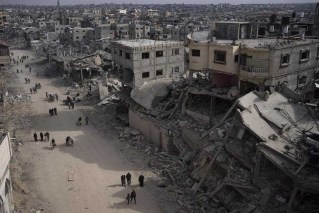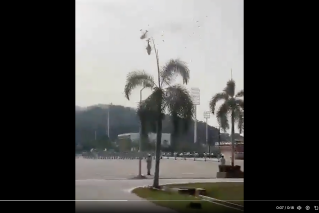Race against time to find workers trapped after Himalayan glacier collapse

As many as 150 people are feared dead after a Himalayan glacier broke and crashed into two dams in northern India.
A video shared by officials and taken from the side of steep hillside shows a wall of water surging into one of the dams and breaking it into pieces with little resistance before continuing to roar downstream.
Local media reports seven bodies were found in the aftermath of the flood, which also forced the evacuation of villages downstream.
In good news, rescuers pulled a group of men out from underneath the mud and debris after they went missing while working on a hydro-power plant.
Heartwarming footage of their rescue shows one worker lifting his arms in celebration as he is pulled to safety after becoming trapped underground.
The brave #Himveers of @ITBP_official rescuing people from a tunnel near Tapovan, #Uttarakhand this evening.
The glacier burst incident in #Chamoli is unfortunate & efforts are being made to rescue people & control the damage. Praying for the safety of all those affected. pic.twitter.com/nz6jfSPgnu
— G Kishan Reddy (Modi Ka Parivar) (@kishanreddybjp) February 7, 2021
No time to run
An eyewitness said he saw a wall of dust, rock and water as an avalanche roared down a river valley.
“It came very fast, there was no time to alert anyone,” Sanjay Singh Rana, who lives on the upper reaches of Raini village, told Reuters by phone.
I felt that even we would be swept away.’’

Rescuers prepare to search for survivors after the glacier collapse. Photo: Getty
Locals fear that people working at a nearby hydro-power project had been swept away, as well as villagers roaming near the river looking for firewood or grazing their cattle, Mr Rana said.
The Rishiganga hydropower plant was destroyed, while the Dhauliganga hydropower was damaged, said Vivek Pandey, a spokesman for paramilitary Indo Tibetan Border Police.
Our brave ITBP personnel performing rescue operations in Uttarakhand. We are committed to help our people in need. @ITBP_official pic.twitter.com/CYpkZIbp05
— Amit Shah (Modi Ka Parivar) (@AmitShah) February 7, 2021
Mr Pandey said bodies were recovered near a tunnel at the Dhauliganga project, where at least 16 workers had been trapped.
Another 140 workers at the two plants were missing, he said.
India has also put many of its northern districts on high alert.
“The flow of the Alaknanda River beyond Nandprayag [stretch] has become normal,” Uttarakhand Chief Minister Trivendra Singh Rawat said on Twitter.
“The water level of the river is now 1 meter above normal but the flow is decreasing.”
Uttarakhand in the Himalayas is prone to flash floods and landslides. In June 2013, record rainfall caused devastating floods that claimed close to 6000 lives.
That disaster was dubbed the “Himalayan tsunami” by the media due to the torrents of water unleashed in the mountainous area, which sent mud and rocks crashing down, burying homes, sweeping away buildings, roads and bridges.
-with AAP








